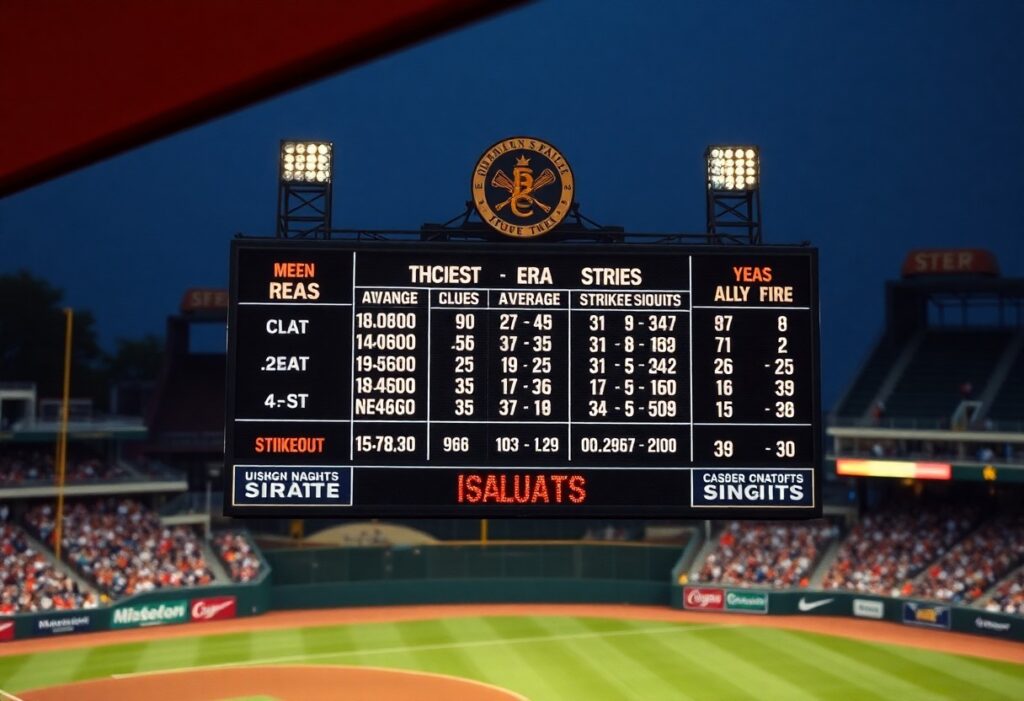
Many baseball bettors struggle to identify the most valuable statistics that can give them a competitive edge in their wagering decisions. While traditional stats like batting average and wins-losses tell part of the story, advanced metrics provide deeper insights into team performance and player value that can significantly impact your betting success. Understanding key indicators such as WHIP, OPS, and bullpen ERA allows you to make more informed predictions about game outcomes. However, relying solely on statistics without considering situational factors can lead to costly mistakes, as baseball’s unpredictable nature means even the best metrics don’t guarantee wins.
Decoding Offensive Metrics: The Key to Scoring
Offensive statistics form the backbone of successful baseball betting, yet many bettors rely on outdated metrics that tell only part of the story. Modern offensive analysis goes far beyond traditional counting stats, stepping into efficiency metrics that reveal which teams consistently create scoring opportunities. You’ll find that teams with superior offensive metrics often provide better value in run totals and moneyline bets, particularly when the market hasn’t fully adjusted to their underlying performance indicators.
Batting Average vs. On-Base Percentage: Understanding the Basics
Batting average misleads bettors by ignoring walks and hit-by-pitches, which contribute equally to scoring potential. On-base percentage provides a more complete picture of offensive efficiency by measuring how frequently players reach base through any means. Teams with significantly higher OBP than batting average typically feature patient hitters who work deep counts and create more scoring opportunities. You should prioritize OBP when evaluating offensive matchups, as teams with .340+ OBP score approximately 1.2 more runs per game than those below .310, regardless of batting average differences.
The Power of Slugging Percentage: More Than Just Hits
Slugging percentage measures the total bases per at-bat, distinguishing between singles and extra-base hits that drive in runs. Teams with slugging percentages above .450 convert scoring opportunities at significantly higher rates than contact-heavy lineups that rely on singles. You’ll notice that high-slugging teams perform better in clutch situations and provide more consistent over betting value in run totals.
The mathematical relationship between slugging percentage and run production becomes particularly evident in playoff scenarios and high-pressure games. Teams that slug .500 or higher average 5.8 runs per game compared to 4.1 runs for teams below .400 slugging. This gap widens against quality pitching, where the ability to drive in runs with fewer hits becomes paramount. You should pay special attention to slugging percentage differentials when betting totals, as matchups featuring one team with significantly higher slugging often exceed projected run totals. Additionally, road teams with slugging advantages of .050 or more cover run lines 58% of the time, making this metric particularly valuable for identifying undervalued offensive units in hostile environments.
The Art of Pitching Analytics: What Matters Most
Pitching statistics tell stories that traditional wins and losses never could. Advanced metrics reveal the true skill level of a pitcher by stripping away the influence of defense, luck, and run support. You’ll find that elite pitchers consistently excel in specific measurable areas that directly correlate with preventing runs and limiting baserunners. Understanding these key indicators allows you to identify value bets when the market overvalues name recognition or recent performance while undervaluing underlying statistical excellence.
Earned Run Average (ERA) vs. WHIP: Measuring Pitching Effectiveness
ERA measures runs allowed per nine innings, but WHIP (Walks + Hits per Inning Pitched) often provides a clearer picture of pitching effectiveness. A pitcher with a 2.50 ERA might seem dominant until you discover his 1.45 WHIP indicates he’s allowing significant baserunner traffic. Conversely, a pitcher sporting a 3.20 ERA with a 1.05 WHIP likely possesses superior command and control. Elite pitchers typically maintain WHIP values below 1.20, while anything above 1.40 signals potential trouble regardless of current ERA.
Strikeout Rate and Walk Rate: Indicators of a Pitcher’s Dominance
Strikeout rate (K/9) and walk rate (BB/9) reveal a pitcher’s true command and stuff quality. Pitchers with K/9 rates above 9.0 demonstrate the ability to miss bats consistently, while those maintaining BB/9 below 3.0 show excellent control. The combination creates a powerful predictor of sustained success.
The K/BB ratio amplifies this analysis by showing the relationship between these two critical skills. Pitchers with K/BB ratios above 3.0 typically outperform their current statistics, making them excellent betting targets when undervalued. Jacob deGrom’s 2018 Cy Young season exemplified this principle with a 10.8 K/9, 1.8 BB/9, and spectacular 6.0 K/BB ratio. Meanwhile, pitchers showing declining strikeout rates or increasing walk rates often experience rapid deterioration in performance, creating profitable fade opportunities before the market adjusts to their declining skills.
Advanced Metrics: Diving Deeper into Performance
Beyond traditional statistics lies a treasure trove of advanced metrics that reveal the true story behind player performance. These sophisticated measurements strip away luck, context, and small sample size noise to expose genuine talent levels. Savvy bettors leverage these metrics to identify value where casual observers see only surface-level numbers, creating profitable opportunities in markets that haven’t fully adjusted to analytical insights.
- WAR (Wins Above Replacement) – Comprehensive player value
- FIP (Fielding Independent Pitching) – True pitching performance
- xFIP (Expected Fielding Independent Pitching) – Normalized home run rates
- wOBA (Weighted On-Base Average) – Offensive contribution weighting
- BABIP (Batting Average on Balls in Play) – Luck indicator
| Metric Category | Primary Use Case |
| Predictive Metrics | Forecasting future performance trends |
| Context-Independent Stats | Isolating individual skill from team factors |
| Luck Indicators | Identifying regression candidates |
| Comprehensive Value | Overall player impact assessment |
WAR (Wins Above Replacement): A Comprehensive Value Assessment
WAR quantifies how many additional wins a player contributes compared to a readily available replacement-level player at the same position. A player worth 6+ WAR typically represents MVP-caliber performance, while anything above 2.0 WAR indicates above-average contribution. You can use WAR to identify undervalued players whose betting lines don’t reflect their true impact, particularly when comparing players across different positions or evaluating trade acquisitions mid-season.
FIP and xFIP: Evaluating Pitching Beyond Traditional Stats
FIP focuses exclusively on outcomes pitchers directly control: strikeouts, walks, hit-by-pitches, and home runs. When a pitcher’s ERA significantly exceeds their FIP, regression toward the FIP value often follows, creating betting opportunities on future performances. xFIP takes this further by normalizing home run rates to league average, accounting for ballpark effects and small sample luck.
Consider a pitcher with a 4.50 ERA but a 3.20 FIP through their first eight starts – this gap suggests they’ve been victimized by poor defense or sequencing luck. Betting on this pitcher’s future success becomes profitable when oddsmakers rely heavily on ERA-based assessments. Conversely, pitchers significantly outperforming their FIP may be due for negative regression, making them fade candidates despite impressive traditional numbers. The metric proves especially valuable when evaluating pitchers changing teams or ballparks, as it isolates their true skill level from environmental factors.
Context Matters: Importance of Game Situations
Raw statistics tell only part of the story when you’re evaluating baseball bets. A player’s .300 batting average becomes meaningless if he consistently fails with runners in scoring position, while a pitcher’s 3.50 ERA might mask his tendency to surrender home runs in high-leverage situations. Game context transforms ordinary performances into extraordinary ones, making situational awareness your most valuable betting tool. You’ll discover that clutch performers often defy their season-long numbers when the stakes are highest, creating profitable opportunities for sharp bettors who dig deeper than surface-level stats.
Win Probability Added (WPA): The Impact of Clutch Performances
WPA measures how much a player’s actions increase or decrease his team’s chances of winning in real-time game situations. A two-run homer in the ninth inning carries exponentially more WPA value than the same hit in the second inning, even though both appear identical in box scores. Players like David Ortiz built reputations on high WPA performances, consistently delivering when games hung in the balance. You can exploit this metric by identifying players whose WPA significantly exceeds their traditional stats, signaling clutch ability that oddsmakers often undervalue in critical game situations.
Situational Statistics: Runners in Scoring Position and Late-Inning Success
Batting averages with runners in scoring position (RISP) reveal which hitters excel under pressure and which crumble when games matter most. Some players see their averages drop 50+ points with RISP, while others thrive in these moments. Late-inning performance splits expose similar patterns, showing how players perform in the seventh inning and beyond when fatigue and pressure peak.
Teams like the 2019 Washington Nationals demonstrated the power of situational hitting, ranking among the best in baseball with RISP during their championship run despite mediocre overall offensive numbers. You should track how teams perform in high-leverage at-bats over recent games rather than season-long averages, as hot and cold streaks in clutch situations often persist for weeks. Pitchers also show dramatic splits in late innings – some maintain their effectiveness while others see their command deteriorate after the sixth inning. Monitor relief pitcher usage patterns and recent workloads, as overworked bullpens frequently collapse in crucial moments, creating valuable betting opportunities on opposing offenses.
Betting Strategy: Applying Stats for Success
Your statistical analysis becomes profitable only when you transform raw data into actionable betting decisions. Successful baseball bettors focus on 3-5 key metrics rather than drowning in endless statistics, creating a systematic approach that identifies value opportunities. You’ll want to establish clear thresholds—such as backing teams with a starter posting an ERA below 3.50 against lineups striking out more than 9.2 times per game. Professional bettors typically achieve 54-56% win rates by consistently applying statistical filters, proving that disciplined metric application trumps gut instincts every time.
Analyzing Matchups: How Stats Influence Bet Selection
Pitcher-versus-lineup matchups reveal the most profitable betting angles when you dig beyond surface-level ERA comparisons. Left-handed starters historically hold a .237 batting average advantage against right-heavy lineups, while teams facing opposite-handed pitching for the first time in a series show 15% lower run production. You should prioritize matchups where starting pitchers face lineups with high strikeout rates against their pitch types—fastball-heavy pitchers against teams ranking bottom-10 in fastball contact rate typically justify run line bets.
Trend Analysis: Recognizing Patterns Over Time
Statistical trends emerge most clearly over 15-20 game samples, where temporary hot streaks separate from genuine performance shifts. Teams posting BABIP (Batting Average on Balls in Play) above .340 over three weeks typically regress 40-60 points within the next 10 games, creating valuable fade opportunities. You’ll find the most reliable trends in pitching metrics—starters with rising walk rates over four consecutive outings maintain that decline 73% of the time in their next appearance.
Seasonal timing amplifies certain statistical trends, particularly as weather patterns and player fatigue accumulate. Power numbers spike 23% during the final six weeks of the season as temperatures rise and pitchers lose velocity, making over bets more valuable in late August and September games. You should track how teams perform in specific calendar months—the Cubs historically struggle in April with a .420 winning percentage over the past decade, while the Astros post .640 marks in June. Home field advantage decreases by 12% after the All-Star break as travel fatigue equalizes, making road favorites more attractive in late-season matchups. Monitor bullpen usage patterns during hot streaks, as overworked relievers typically see their effectiveness drop 18% after appearing in four of six games.
Final Words
Summing up, successful baseball betting requires your mastery of key statistical indicators that drive game outcomes. You should focus on advanced metrics like ERA+, WHIP, and OPS rather than relying solely on basic statistics. Your analysis must incorporate situational factors such as bullpen performance, home/away splits, and recent form trends. Weather conditions and ballpark dimensions significantly impact scoring, making them important components of your betting strategy. By consistently applying these analytical frameworks and tracking the right metrics, you position yourself to make informed decisions that can lead to profitable long-term results in baseball wagering.


